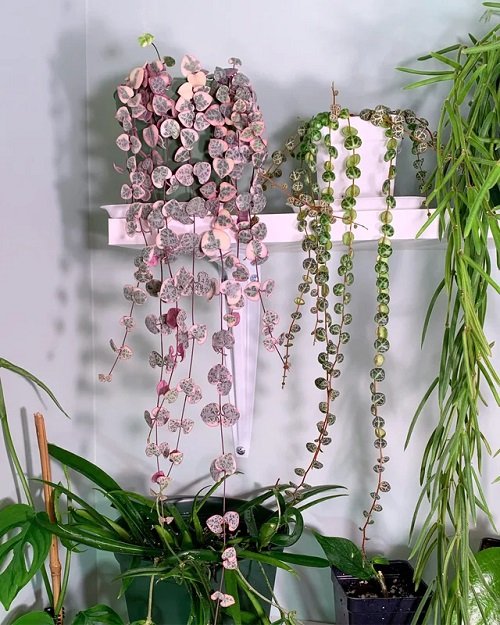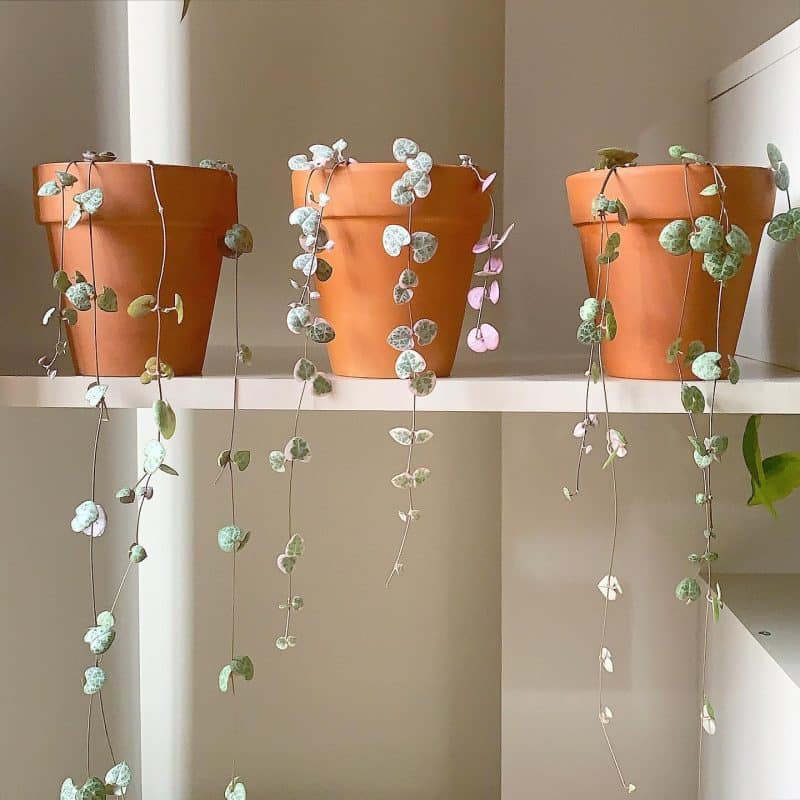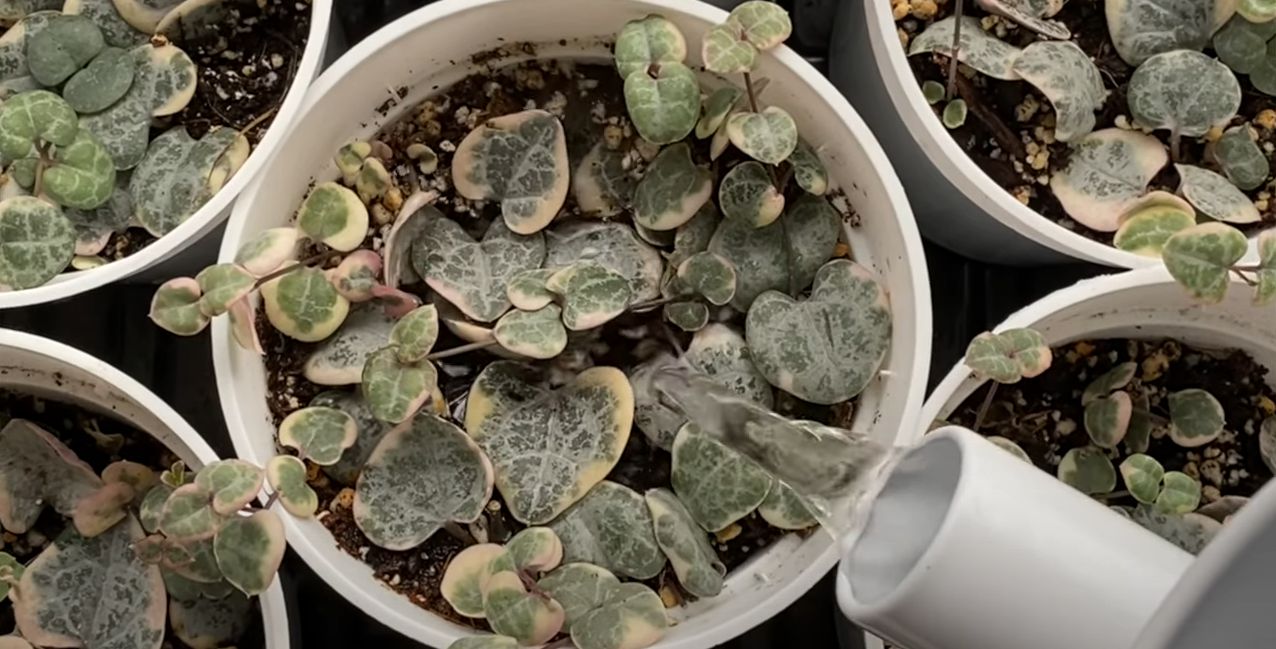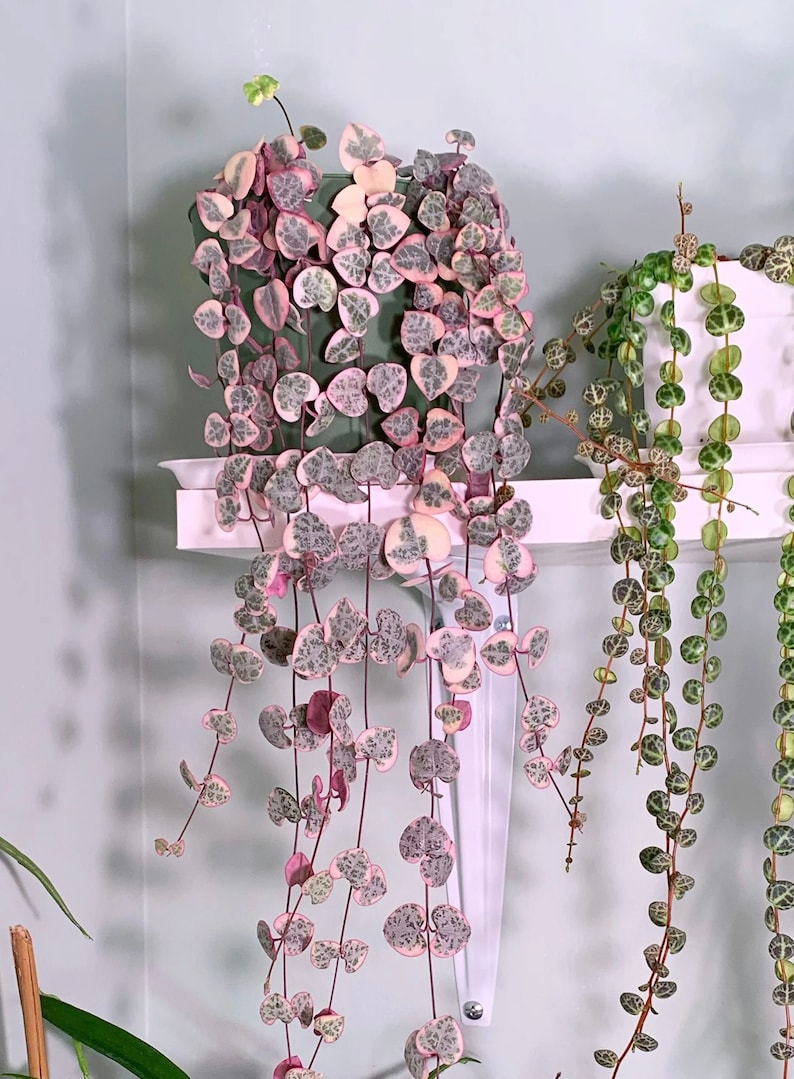What is a String of Hearts Plant, and is it a Succulent?
The String of Hearts plant, scientifically known as Ceropegia woodii, is a unique and captivating plant species that has gained popularity among plant enthusiasts in recent years. With its trailing stems and heart-shaped leaves, it’s easy to see why this plant has become a favorite among many. However, there is ongoing debate about whether the String of Hearts plant is a true succulent. In this article, we’ll delve into the characteristics of succulents and explore how the String of Hearts plant compares.
So, are String of Hearts succulents? While they share some similarities with traditional succulents, such as thickened leaves and stems, they also exhibit some distinct differences. To understand whether the String of Hearts plant can be classified as a succulent, it’s essential to examine its characteristics and growth habits. In the following sections, we’ll discuss the defining features of succulents and how the String of Hearts plant measures up.
The String of Hearts plant is native to South Africa and is a member of the Apocynaceae family. It’s a relatively low-maintenance plant that thrives in well-draining soil and partial shade. Its trailing stems can grow up to 3 feet long, making it an excellent choice for hanging baskets or containers. But what sets the String of Hearts plant apart from other succulents, and how can you care for it to ensure optimal health and growth?
Characteristics of Succulents and How String of Hearts Compares
Succulents are a diverse group of plants that have adapted to survive in environments with limited water availability. One of the defining characteristics of succulents is their ability to store water in their leaves, stems, or roots. This is achieved through the development of thickened, fleshy tissues that can retain water, allowing the plant to survive for extended periods without rain. Other common characteristics of succulents include CAM (crassulacean acid metabolism) photosynthesis, which enables them to open their stomata at night and store water, and the presence of waxy or powdery coatings on their leaves to prevent water loss.
So, how does the String of Hearts plant compare to other succulents? While it shares some similarities, such as thickened leaves and stems, it also exhibits some distinct differences. For example, the String of Hearts plant does not have the same level of water storage capacity as some other succulents, and its leaves are not as fleshy or thickened. Additionally, the String of Hearts plant does not have CAM photosynthesis, and its stomata are not adapted to open at night. Despite these differences, the String of Hearts plant is still a low-maintenance plant that can thrive in well-draining soil and partial shade, making it a great option for plant enthusiasts who want to add a unique and beautiful plant to their collection.
Another key characteristic of succulents is their ability to tolerate drought and neglect. While the String of Hearts plant can survive with minimal watering, it will still require regular watering to maintain its health and appearance. In fact, overwatering is one of the most common mistakes people make when caring for a String of Hearts plant, which can lead to root rot and other problems. By understanding the unique characteristics of the String of Hearts plant and how it compares to other succulents, you can provide the best possible care and enjoy its beautiful, trailing stems and heart-shaped leaves.
How to Care for Your String of Hearts Plant
Providing the right care for your String of Hearts plant is crucial to maintaining its health and appearance. While it’s a relatively low-maintenance plant, it still requires attention to its lighting, watering, temperature, and fertilization needs. In this section, we’ll explore the specific care requirements for the String of Hearts plant, so you can ensure it thrives in your care.
Lighting is one of the most critical factors in caring for a String of Hearts plant. It prefers bright, indirect light, but can tolerate partial shade. Direct sunlight can cause the leaves to become scorched, so it’s essential to provide filtered light, especially during the hottest part of the day. East- or west-facing windows are ideal for String of Hearts plants, as they provide gentle, indirect light.
Watering is another crucial aspect of caring for a String of Hearts plant. It prefers well-draining soil and should be watered sparingly, allowing the soil to dry out completely between waterings. Overwatering is the most common cause of death in String of Hearts plants, so it’s essential to be cautious with watering. Water your plant when the top inch of soil feels dry to the touch, and avoid getting water on the leaves to prevent rot.
Temperature is also an essential factor in caring for a String of Hearts plant. It prefers temperatures between 65°F to 75°F (18°C to 24°C), which is typical for most indoor spaces. Avoid placing your plant near heating or cooling vents, fireplaces, or drafty windows, as this can cause stress to the plant.
Fertilization is also necessary to promote healthy growth and development in your String of Hearts plant. Use a balanced, water-soluble fertilizer during the growing season (spring and summer), and dilute it to half the recommended strength to avoid burning the roots. You can also use a fertilizer specifically formulated for cacti and succulents, as these plants have similar nutritional needs.
By following these care guidelines, you can ensure your String of Hearts plant thrives and remains healthy and beautiful. Remember to monitor your plant’s specific needs and adjust your care routine accordingly. With proper care, your String of Hearts plant can become a stunning addition to your indoor space.
Propagating String of Hearts: A Step-by-Step Guide
Propagating a String of Hearts plant is a relatively straightforward process that can be done using stem cuttings. This method is ideal for plant enthusiasts who want to share their favorite plant with friends or expand their own collection. In this section, we’ll provide a step-by-step guide on how to propagate a String of Hearts plant using stem cuttings.
Step 1: Prepare the Cutting – Choose a healthy stem with at least two nodes (the joint where a leaf meets the stem). Cut the stem just below a node using a sharp, sterile knife or pruning tool. Make sure the cutting is around 4-6 inches long to ensure it has enough energy to root.
Step 2: Remove Lower Leaves – Carefully remove the lower leaves from the cutting, leaving only a few leaves at the top. This will help prevent the cutting from drying out and reduce the risk of root rot.
Step 3: Allow the Cutting to Dry – Place the cutting on a paper towel or dry cloth for 1-2 days to allow the cut end to dry out. This will help prevent root rot and promote healthy rooting.
Step 4: Plant the Cutting – Fill a small pot or propagation tray with well-draining soil, and plant the cutting about 1-2 inches deep. Water the soil gently but thoroughly, and make sure the soil is moist but not waterlogged.
Step 5: Provide Humidity and Warmth – Place the pot or propagation tray in a warm, humid location with bright, indirect light. Keep the soil consistently moist but not waterlogged, and provide temperatures between 65°F to 75°F (18°C to 24°C).
Step 6: Monitor and Maintain – Monitor the cutting for signs of rooting, such as new growth or resistance to gentle tugging. Maintain the soil moisture and humidity levels, and provide fertilization once the new plant is established.
By following these steps, you can successfully propagate a String of Hearts plant using stem cuttings. Remember to be patient, as rooting can take several weeks to several months. With proper care and attention, your new plant will thrive and become a beautiful addition to your collection.
Common Problems and Pests that Can Affect String of Hearts
Like any plant, the String of Hearts can be susceptible to certain problems and pests. In this section, we’ll discuss some of the most common issues that can affect String of Hearts plants and provide advice on how to identify and address them.
Overwatering is one of the most common problems that can affect String of Hearts plants. This can cause the roots to rot, leading to a range of symptoms including yellowing leaves, droopy stems, and a soft, mushy texture. To avoid overwatering, make sure to check the soil moisture regularly and only water when the soil feels dry to the touch.
Underwatering is another common problem that can affect String of Hearts plants. This can cause the leaves to become wrinkled and dry, and the stems to become brittle and prone to breakage. To avoid underwatering, make sure to water your plant regularly, but avoid getting water on the leaves to prevent rot.
Pests are another common problem that can affect String of Hearts plants. Mealybugs and spider mites are two of the most common pests that can infest String of Hearts plants. Mealybugs are small, white, cottony insects that feed on the sap of the plant, while spider mites are tiny, spider-like insects that feed on the leaves and stems. To control pests, use insecticidal soap or neem oil, and make sure to isolate infected plants to prevent the spread of pests.
Root rot is another common problem that can affect String of Hearts plants. This is usually caused by overwatering, which can cause the roots to rot and the plant to become unstable. To prevent root rot, make sure to water your plant carefully and avoid getting water on the leaves or crown of the plant.
By being aware of these common problems and pests, you can take steps to prevent them and keep your String of Hearts plant healthy and thriving. Remember to monitor your plant regularly and take action quickly if you notice any signs of problems or pests.
String of Hearts vs. Other Trailing Succulents: A Comparison
While the String of Hearts plant is a unique and beautiful succulent, it’s not the only trailing succulent on the market. In this section, we’ll compare the String of Hearts plant to other popular trailing succulents, such as the Burro’s Tail and the Donkey’s Tail.
The Burro’s Tail (Sedum morganianum) is a popular trailing succulent that is known for its long, trailing stems and plump, blue-green leaves. Like the String of Hearts plant, the Burro’s Tail is a low-maintenance succulent that is easy to care for and can thrive in a variety of lighting conditions. However, the Burro’s Tail has a more delicate appearance than the String of Hearts plant, with smaller leaves and a more fragile stem.
The Donkey’s Tail (Sedum burrito) is another popular trailing succulent that is similar to the String of Hearts plant. It has long, trailing stems and plump, blue-green leaves, but it is more compact than the String of Hearts plant and has a more rounded appearance. The Donkey’s Tail is also a low-maintenance succulent that is easy to care for, but it requires more frequent watering than the String of Hearts plant.
So, how does the String of Hearts plant compare to these other trailing succulents? While all three plants are low-maintenance and easy to care for, the String of Hearts plant has a more unique and beautiful appearance than the other two plants. Its heart-shaped leaves and trailing stems make it a standout in any succulent collection, and its ability to thrive in a variety of lighting conditions makes it a great choice for indoor gardens.
Ultimately, the choice between the String of Hearts plant and other trailing succulents will depend on your personal preferences and needs. If you’re looking for a low-maintenance succulent with a unique and beautiful appearance, the String of Hearts plant may be the perfect choice for you.
Displaying Your String of Hearts Plant: Creative Ideas and Inspiration
Now that you’ve learned how to care for your String of Hearts plant, it’s time to think about how to display it. This unique and beautiful plant deserves a special showcase, and there are many creative ways to do so. In this section, we’ll explore some ideas for displaying your String of Hearts plant, including hanging baskets, terrariums, and topiaries.
Hanging baskets are a great way to showcase your String of Hearts plant, as they allow the trailing stems to cascade down and create a beautiful display. Choose a basket that is at least 6-8 inches deep to give the roots of the plant enough room to grow. You can also add some decorative rocks or moss to the basket to give it a more polished look.
Terrariums are another great way to display your String of Hearts plant. These miniature gardens are perfect for showcasing small plants like the String of Hearts, and they can be made in a variety of containers, from glass jars to wooden boxes. Simply add some soil, rocks, and decorative elements like moss or small branches, and you’ll have a beautiful and unique display.
Topiaries are a more advanced way to display your String of Hearts plant, but they can be a stunning addition to any room. To create a topiary, you’ll need to train the stems of the plant to grow up a trellis or other support. This can take some time and patience, but the end result is well worth it. You can also add some decorative elements like ribbons or bows to the topiary to give it a more polished look.
These are just a few ideas for displaying your String of Hearts plant, but there are many other creative ways to do so. You can also try using a macrame hanger, a wooden planter, or even a glass vase to showcase your plant. Whatever method you choose, make sure it’s one that you enjoy and that showcases the beauty of your String of Hearts plant.
Conclusion: Why String of Hearts is a Great Addition to Any Plant Collection
In conclusion, the String of Hearts plant is a unique and beautiful addition to any plant collection, succulent or not. With its trailing stems and heart-shaped leaves, it’s a standout in any room. But beyond its aesthetic appeal, the String of Hearts plant is also a low-maintenance and easy-to-care-for plant that can thrive in a variety of conditions.
As we’ve discussed throughout this article, the String of Hearts plant is not a traditional succulent, but it does share some characteristics with succulents, such as its ability to store water in its leaves and stems. However, it also differs in significant ways, making it a fascinating and rewarding plant to grow.
Whether you’re a seasoned plant enthusiast or just starting out, the String of Hearts plant is a great choice for anyone looking to add some greenery to their space. With its unique appearance and low-maintenance requirements, it’s a plant that can bring joy and beauty to any room.
So, if you’re thinking of adding a String of Hearts plant to your collection, don’t hesitate. With the right care and attention, this plant can thrive and become a stunning addition to your home. And who knows, you may just find yourself falling in love with this charming and unique plant.








